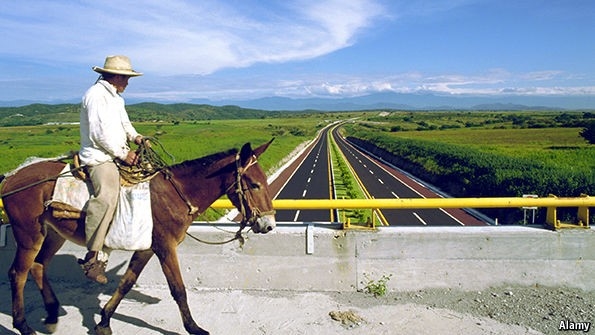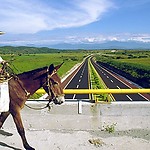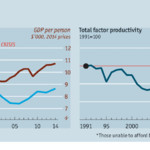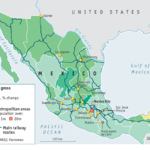OUTSIDE San José Chiapa, a somewhat shabby town of 8,000 in the Mexican state of Puebla, a vast box-like factory complex is rising out of the fields like a mirage, attended by new highways, flyovers and roundabouts for its lorries and executives. Audi, a German carmaker, is investing $1.3 billion into this project. From 2016 production of its snazzy Q5, which is currently made in Ingolstadt, near Munich, will be moved here instead. Cars from San José Chiapa will be shipped around the world.
Volkswagen, Audi’s parent company, has been building cars in Puebla for decades. Mexico’s position between two continents and two oceans, bolstered by free-trade agreements with 45 countries, has made it attractive to such manufacturers. The Germans have favoured Puebla, which lies to the east and south of Mexico City; the Japanese Aguascalientes, to the north-west: they have turned Mexico into the world’s fourth-largest car exporter.
“How Audi are you?” asks a sign in the company’s smart recruitment centre in San José Chiapa. For the 100,000 people from around the country, mostly engineers and technicians, who have applied for the 3,800 jobs so far offered, the answer is “As Audi as you want me to be”.
“About as Audi as a horse-drawn cart,” though, would be the frank answer of most people living nearby. Audi recruits need a secondary-school education; many of the locals never got past primary. More than half of the people round the city depend on farming small plots for a living. In the fields surrounding the plant, dozens of men in big hats are bent-backed over their hoes. Not a tractor is in sight.
One of the farmers, Abel Ramírez, leads his horse and cart across a new highway, the wheels leaving thin ruts in the mud either side of the road. The lorries bound for the Audi plant make his horse skittish as they swish by. He is anxious about Audi’s impact on his livelihood. Workers from out of town have brought with them worries about crime and, horror of horrors, health-and-safety concerns. For how long, Mr Ramírez wonders, will he be able to keep his horse, pigs and cows in barns attached to his home before one of the Audi factory’s employees complains? “I’m a Mexican Aztec peasant and this is the way we are. But what if I offend others?” he asks.
Magdaleno Valencia, a neighbouring farmer, is more optimistic. “We used to produce milk,” he says, pretending to squeeze udders. “Now we produce Audis.” His cheerfulness stems from promises that the government will set up a university in San José Chiapa to provide technicians for the car industry. Mr Valencia thinks this means that, although few of today’s townspeople can dream of anything other than a menial job at the factory, their children will have good cause to aim higher.
José Munguía, the local priest, agrees that the current generation has missed out. He says that the farmers who sold their land to Audi mostly blew the money on family parties rather than investing it. (“None of it even came to the church,” he sniffs.) They have not built hotels, or started new businesses supplying the plant, because they lack the skills and imagination. The government should have provided programmes on developing such businesses, he believes. It blew the opportunity.
Tontos v correctos
The ways prosperity and modernity spread—or do not spread—around Mexico have been a subject of debate and study for a century or so. In 1926 Robert Redfield, an anthropologist from the University of Chicago who did much to introduce the study of modernisation into the social sciences, settled himself in Tepoztlán, a charming cobbled town 50km south of Mexico City, for fieldwork. He expressed what he observed in terms of a gap between “los correctos” (the correct), the local elite who were gradually absorbing city ways, and “los tontos” (the fools) who stuck with old traditions.
The gap had a spatial dimension. Near the town’s plaza were the biggest houses and the most competitive artisans; interaction with visitors and tradespeople from outside meant that big-city culture was strongest there. Farther out, the jobs became more traditional; midwives, herbal doctors and firework-makers. At the very edge of town people did not even tell the time; there were no watches, and they were too far away from the plaza to hear the church bell. But though such patterns were part of the story, there was more to it. The tontoswere removed from modernity not merely by the walk to the town centre, but by their habits of mind.
Spatial divisions in Mexico’s modernisation are still obvious today. As Ricardo Hausmann of Harvard University’s Centre for International Development points out, economic productivity in Nuevo León, a heavily industrialised state close to the American border, is at South Korean levels. In the south of Mexico it is close to that of Honduras. The country’s industrial clusters devoted to the manufacture of cars, planes, electric goods and electrical equipment—categories which between them account for two-thirds of Mexico’s manufacturing exports, and thus for about 18% of GDP—are largely to be found in a band next to its northern border and in the central states below it. These states account for about 70% of the 120m population.
This part of the country is criss-crossed by trunk roads, railways and gas pipelines which make it an attractive manufacturing destination. Some economists see these networks as defining the continent’s “new frontier”; where once the Rio Grande was the border between modernisation and underdevelopment, now the boundary is formed by the edges of this new infrastructure. Luis Rubio of CIDAC, a think-tank, notes that within these areas “NAFTA [the North American Free Trade Agreement] sets the rules of business”, meaning they operate under a modern legal structure different from the somewhat arbitrary justice seen in the rest of the economy.
It is in these regions that you find an elite not unlike Redfield’s correctos. Its members have benefited from the reforms that have made Mexico a model of free trade and sound money over the past two decades, casting off its prior dependence on providing raw materials. They fly abroad on holiday, drink wine and fine tequila, and send their children to private schools.
The din of the street
But the bulk of the population continues to live in a land that President Enrique Peña Nieto described in his inaugural address, three years ago, as one of “backwardness and poverty”. This is the Mexico of changarros (makeshift food stands), informal markets, cash-only family firms, peasant farmers and indigenous communities, as well as a vicious underworld. It is where half the population remains poor, on government figures, despite the promise of NAFTA, which came into force in 1994 (see chart). Its inhabitants may not pay tax, but extortionists, bent lawyers, judges and officials often shake them down for cash.
This periphery is, paradoxically, where most jobs are created. But such is the burden it imposes on the economy that from 1990-2013 overall productivity in Mexico fell by 0.3% on average each year: labour, capital and technology became ever less efficient over almost two-and-a-half decades. “Probably no country in the world presents a starker contrast between external success and domestic failure,” writes Dani Rodrik of Harvard.
On two occasions, 20 years apart, problems in the poorest bit of this second Mexico, its deep south, have thrown the country off course just when it appeared to be on the cusp of big economic breakthroughs. In 1994 the “Zapatista” indigenous uprising in Chiapas, the southernmost state, knocked the lustre off the launch of NAFTA and helped trigger the peso crisis less than a year later. In 2014 the drug-related massacre of 43 students in the southern state of Guerrero battered Mr Peña’s credibility just as he was basking in the completion of 11 economic and political reforms that had started to win him international acclaim.
It is wrong to think of the division between the modern Mexico and the rest of the country as purely one between north and south. As San José Chiapa shows, the distance between them is not just to be measured in kilometres; it is to be mapped in terms of formality and informality, the rule of law and its absence, of race and of culture. The Economic Productivity Unit set up by the government in 2013 blames dismal output on excessive informality, insufficient finance, lack of worker training, weak managerial capabilities and excessive regulation, crime and corruption. Its boss, Ernesto López-Córdova, has direct experience of the informal economy; his office in the capital’s historic centre is above a cobbled street so full of hawkers that it is hard to hear him. As the din makes clear, low-productivity Mexico is not simply a creature of the countryside (though it is true that Mexicans are less likely to live in cities than other Latin Americans).
Mr Hausmann, one of the unit’s advisers, would like to get more people into the big cities. The fact that some of Mexico is now rich, he says, means that countrywide factors, such as a weak constitution or poor basic education, cannot be the main problem. Geography may not be everything, but it does matter. He thinks the most important thing is to get unproductive workers the specific improvements in their skills they need for better jobs and with safe, reliable ways of getting to those jobs.
Those taking a more sociological view, though, see a different problem. They say that many Mexicans feel that the top-down model of development does not offer them the sort of stability they value. That stability, such people think, is instead to be found in the small businesses in which they mostly work—businesses that are embedded in a culture of family ties rather than rugged individualism. Gabriel Zaid, a Mexican writer who first focused on Mexico’s productivity problems in the late 1970s, says that today’s factories cannot provide the jobs needed by the 55m Mexicans under 25. Small-scale business activity, in contrast, provides plentiful employment; he contends that they could raise Mexico’s productivity with relatively little investment.
Some link this cultural reluctance to modernise to the dogged survival of the México profundo—the chunk of society where cultural links to the ancient Mesoamerican civilisation are still strongly felt. David Robichaux, of Mexico’s Iberoamerican University, says that this part of Mexico is not limited to the 7m or so speakers of indigenous languages. He reckons tens of millions of mestizo (mixed-race) Mexicans share family and community values that are as important to them as notions of modernisation and progress, and sometimes inimical to those ideas and their implementation. These people are not all poor. Many run small firms—but rather than reinvesting to improve their businesses’ efficiency, they may prefer to splash out on village fiestas and family gatherings.
The persistent attachment to scruffy, informal farms and firms may be in part a cultural choice; it is surely also, though, a consequence of earlier failures. Many Mexicans remain small-business people because they lack the skills, contacts or possibilities to become more entrepreneurial, or better paid and better treated—but more routinely taxed—salary earners. The romantic notions of the México profundo are often peddled by interest groups that benefit from this status quo, such as unions and old-fashioned political bosses with power bases in peasant communities.
In “Why Regions Fail”—a follow-up to “Why Nations Fail”, a book which he wrote with Daron Acemoglu—James Robinson of Harvard looks at some of these failures and policy biases and the way they affect the south of the country, which is poorer, more unequal and less urbanised than the rest. In colonial Mexico indigenous groups were exploited to benefit a small elite; in the latter two-thirds of the 20th century, the ruling Institutional Revolutionary Party (PRI) controlled a one-party state that left the south in the hands of local barons, he says. It was starved of public funds and infrastructure; to an extent it was made poor, not left poor. “We know today that the south has less efficient legal systems that are less good at enforcing laws and southern states have governments that are more clientelistic and corrupt in the way they interact with citizens,” Mr Robinson writes. He contrasts this with more inclusive institutions emerging elsewhere in the country.
The grasshoppers of hope
Oaxaca, a southern state that has the highest informality and second-lowest productivity in Mexico, was gripped this year by struggles over the merits of modernisation. For a group committed to maintaining a status quo that serves it well look no further than the CNTE, a rebel teachers’ union which has used mob tactics across southern Mexico to thwart reforms. In Oaxaca the union’s Section 22 chapter promotes its own education agenda based around indigenous values such as communal work and village fiestas. It paralysed schools for months in a bid to prevent exam systems being introduced for its members.
On the one hand their tactics appear unforgivable. The state is crying out for a better education system. On the other hand, many Oaxacans can be forgiven for thinking modernisation is a mirage. About a third of Oaxaca’s labour force works in farming, many using oxen instead of tractors to plough the milpas, few within commuting distance of the few well-paying factories. Half the state’s roads are unpaved, and foreign investment is minimal—0.15% of Mexico’s total in 2013, according to a government analysis. One way to keep from despair is to resign yourself to a feeling that this is the way it will always be.
For all this, there are flickers of enterprise. Take a little-known community of ten public universities, the Oaxaca State Universities System, which are aimed at serving people from indigenous communities and at the same time technologically minded. Its rector, a fervently energetic 84-year-old Spaniard called Modesto Seara-Vázquez, says his students from Mixtec and Zapotec races, whose languages, like Mandarin, are tonal, have aptitudes for mathematics and computing similar to those of east Asians.
There is no community decision-making here. Mr Seara-Vázquez runs the universities much as Lee Kuan Yew used to run Singapore. At the Mixteca Technological University, on the outskirts of the ragged city of Huajuapan de León, surrounded by a clump of trees in an otherwise deforested sierra, the campus is litter-free, union-free and politics-free—the one word that carries weight is the rector’s. Students are reschooled for six months after entry to account for what they failed to learn from Oaxaca’s teachers. Those who pass their exams work eight hours a day, must read a classic novel every month, and are usually trilingual, speaking Spanish and English as well as their native tongue. Mr Seara-Vázquez works himself just as hard, notching up 1.2m kilometres on Oaxaca’s potholed roads on his frequent visits to all the campuses. Yet he is repeatedly frustrated by the refusal of businesses to set up in Oaxaca to take advantage of the talent he nurtures. “They just don’t believe it,” he says.
Some students strike out on their own. Two have set up their own firm, Inalim, on the outskirts of the state capital. It produces toasted grasshoppers, a local delicacy that they export as far as France. The acrid smell hits you as soon as you enter the factory, but it is clean and efficient, providing scores of jobs. When they started, their biggest issue was lack of trust. Farmers would not sell grasshoppers to them because they feared they would be cheated; banks would not back them; distributors would not work with them. But they persevered, with a rigorous focus on quality control. Their products are now distributed by Bimbo, a highly efficient Mexican food retailer with operations in the Americas and Europe.
Yet Inalim is an exception, and likely to remain so. Without strong technological underpinning, alliances with bigger firms, and hard-earned trust from banks and customers, most Mexican businesses struggle to grow. These attributes are becoming more abundant in the modern part of Mexico, providing the possibility of prosperity for those who want to move there. For those who don’t, though, they are barely even a distant dream.




